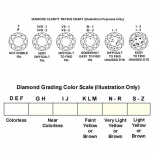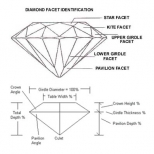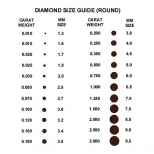Education
DIAMOND BUYING AND THE FOUR C’S
No discussion about buying diamonds in any form is complete without discussing the classic "FOUR C's" of: Clarity, Color, Cut, and Carat weight. Understanding such criteria as diamond grading reports and the factors affecting a diamond's cost (price) will also prove beneficial for increasing the buyer's confidence level that he or she is making a sound decision.
1. Clarity. Clarity measures the relative viability of external blemishes or internal imperfections (inclusions) naturally occurring within a diamond as evaluated by a qualified gemologist. The clarity scale (GIA) is divided into six primary categories:
a. Flawless (F or FL) - no discernable surface blemishes or inclusions visible when viewed at 10x magnification.
b. Internally Flawless (IF) - insignificant surface blemishes and no internal defects visible at 10x magnification,
c. Very, Very Slightly included (VVS-1 & VVS-2) - extremely difficult to very difficult to find surface blemishes or minute inclusions at 10x magnification, but can be more readily seen at 10x once located at 20x magnification,
d. Very Slightly included (VS-1 & VS-2) - difficult to somewhat easy to find surface blemishes or minor inclusions at 10x magnification,
e. Slightly Included (SI-1 & SI-2) - Easy to very easy to find surface blemishes or readily noticeable inclusions at 10x magnification, but will usually appear to be "eye clean" without magnification. If the inclusions are positioned in the body or close the surface of a SI-2 graded diamond typically the inclusions are slightly visible without magnification. This is typically the opposite with SI-1 graded diamonds, where inclusions are typically invisible without magnification regardless of their positioning.
f. Imperfect (I-1, I-2, I-3) - Surface blemishes or obvious inclusions are somewhat difficult, easy, or very easy to find with the naked eye, especially after being located with 10x magnification. I-2 inclusions effect the diamond's aesthetic appearance (beauty) or durability (potential for cracking), I-3 inclusions effect both.
Diamond prices increase dramatically as clarity category lines are crossed. However, SI clarity is generally considered to be the best compromise between cost and appearance, providing excellent value for stones of G/H color and proper proportions (cut). Buyers should exercise caution when making purchases from jewelry merchants who don't know or won't state the clarity of the diamonds offered. Buyers should also be aware that due to the lower value per carat of the small diamonds that commonly make up a diamond jewelry that these diamonds are less tightly graded and broader clarity range (two grades, such as SI-1 to SI-2, or I-1 to I-2) specifications are therefore not uncommon.
2. Color. The color scale is used to evaluate a diamond's internal tint and plays a significant factor in determining its price, colorless being the most desirable. Color is best evaluated in natural light, as high intensity artificial lighting can make the diamond appear to be of a better color grade than it actually is. Larger diamonds should also be examined for fluorescence, as blue photoluminescence will also make the diamond appear to be of a better color grade. GIA Color grades range from:
a. Colorless (D-F) - tint is nearly undetectable to the unaided, trained eye even when compared to the white standard.
b. Near Colorless (G-H) - tint is almost undetectable to the trained eye, but apparent when compared to the white standard.
c. Near Colorless (I-J) - trace of tint is just detectable to the trained eye, but noticeably apparent when compared to the white standard.
d. Faint Yellow to Faint Brown (K-M) - tint is apparent to the trained eye and readily apparent when compared to the white standard.
e. Very Light Yellow to Very Light Brown (N-R) - tint is readily apparent to the unaided, trained eye without comparing to the white standard.
f. Light Yellow to Light Brown (S-Z) - tint is obvious to the unaided, trained eye without comparing to the white standard.
Diamond prices increase significantly as the color scale ascends towards colorless. While "H" color or better diamonds are well presented in either white gold or yellow gold settings, the surfaces of some yellow gold settings may be spot-plated with rhodium (a silver or "white" colored metal six times more costly than gold) to enhance the stone's sparkling appearance. The near colorless grades, "G-H," are generally accepted as providing the best compromise between cost and appearance.
3. Cut. Cut refers to the proportions and shape of the finished diamond, and is the most important element in determining how much light the diamond will reflect. The finished diamond should be symmetrical. The table should be symmetrical, well-centered, and flat, not sloping. The culet should be centered when viewed from the top. The crown and pavilion facets should be properly aligned. And, the girdle should be perfectly round exhibiting a straight edge when viewed from the side. Ideally, the diamond should contain no extra facets, though extra facets may not have a significant adverse impact on its value depending on their shape and placement. From an aesthetic standpoint, a smaller, properly proportioned diamond is generally preferred over an improperly cut stone of greater carat weight and equal price. Acceptable feature proportions are calculated or expressed as a percentage of the diamond's girdle diameter.
A brilliant or round cut diamond has 56 facets in addition to the table and culet surfaces. The "star" facets (8) are the three-pointed, triangular shaped facets which slope slightly from the table and form the top portion of the crown. The "kite" facets (8) are the four-pointed facets spanning the crown surface from the table to the girdle. The "upper girdle" facets (16) are the three-pointed, rounded bottom-edge facets on the crown surface that border the girdle. The "lower girdle" facets (16) are the elongated, three-pointed, rounded top-edge facets on the pavilion surface that border the girdle. And the "pavilion" facets (8) are the elongated, four-pointed facets spanning the pavilion surface from the girdle to the culet.
Cut also affects the "fire" or "brilliance" exhibited by a diamond. Diamonds that are cut too thin or shallow allow the light to pass through the sides of the diamond and appear lifeless, dull, or flat in the center. Diamonds that are cut too deep or high do not reflect enough light back through the top of the diamond and appear to be dark in the center. Diamonds cut to ideal or within acceptable proportions appear to sparkle when rotated or turned from side to side.
4. Carat Weight and Size. Diamonds weights are measured in carats or fraction of carats called points, with 100 points equaling one carat or two-tenths (0.20) of a gram (i.e. 142, one-carat diamonds would weigh one (1) avoirdupois ounce). Diamond prices per carat weight increase exponentially as the average stone size gets larger given the same clarity and color grades. To determine a brilliant (round) cut diamond's millimeter size (diameter) from its carat weight. The Diamond Size Guide below closely approximates actual Millimeter sizes on an 800 x 640 monitor, however for determining actual sizes a millimeter gauge should always be used.
Round Diamond Size Chart to the Right
5. Cost. The primary factors determining cost are: color, clarity, cut, and carat weight. While cut is important, color, clarity, and carat weight generally influence price to a substantially greater degree. With regards to color, clarity, or carat weight, diamond prices do not follow a linear progression (i.e. a two carat diamond is more than two times as expensive as a one carat diamond) with prices growing exponentially. The heavier, whiter, or less included the diamond the rarer it is in nature. For example: A half carat round (.50ct.) with K-color and I-1 clarity is much more common and 11 times less valuable than the same size IF clarity, D color. All other factors (primarily cut) being equal. An I-1 clarity, K color, 50 point stone would cost about $366.00 while an IF clarity, D color, 50 point stone would cost 11 times as much or $4758.00.



